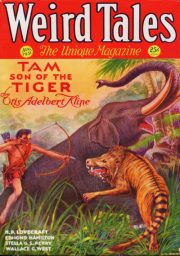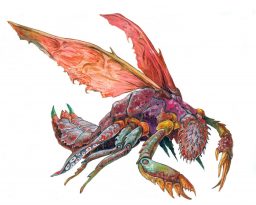The 2016 H. P. Lovecraft Re-read: The Whisperer in Darkness
Sunday , 2, October 2016 Fiction, Short Fiction 9 Comments H. P. Lovecraft’s next story in Weird Tales, “The Whisperer in Darkness” appeared in the August 1931 issue. It had been over two years since a story has appeared under his name. Zealia Brown Reed’s “The Curse of Yig,” essentially a Lovecraft story was in the November 1929 issue of Weird Tales. The end result of Lovecraft revisions of other people’s stories generally ended up something that was mostly Lovecraft.
H. P. Lovecraft’s next story in Weird Tales, “The Whisperer in Darkness” appeared in the August 1931 issue. It had been over two years since a story has appeared under his name. Zealia Brown Reed’s “The Curse of Yig,” essentially a Lovecraft story was in the November 1929 issue of Weird Tales. The end result of Lovecraft revisions of other people’s stories generally ended up something that was mostly Lovecraft.
Lovecraft’s main entries in late 1930 to early 1931 had been the “Fungi From Yuggoth” cycle of sonnets. These had been influenced by Donald Wandrei’s “Sonnets of the Midnight Hours” that had run from May 1928 to May 1929 in Weird Tales.
Lovecraft had competition within the issue of Weird Tales mainly from Clark Ashton Smith who was coming on strong as a weird fictioneer. Wallace West’s “Moon Madness” is actually a good story. Part 2 of Otis Adelbert Kline’s Edgar Rice Burroughs pastiche “Tam, Son of the Tiger” was more typical pulp fare. August Derleth’s “Prince Borgia’s Mass” is one of his stories of the Renaissance Italian city states. Edmond Hamilton was present with the Fortean “The Earth Owners.” Part 1 of Alexandre Dumas’ “The Wolf-Leader” rounded out the issue.
“The Whisperer in Darkness” amounts to 26,624 words. The Complete Fiction states he wrote the story from February 24, 1930 to September 26, 1930. The story is set in rural Vermont instead of Massachusetts.
The story is told in first person by Albert Wilmarth. He is an instructor of literature at Miskatonic University and amateur student of New England folklore. The story starts with floods in Vermont in 1927 and reports of things found floating in the water.
“The were pinkish things about five feet long; with crustaceous bodies bearing vast pairs of dorsal fins or membranous wings and several sets of articulated limbs, and with a sort of convoluted ellipsoid, covers with multitudes of very short antennae, where a head would normally be.”
So we have another entry in a Lovecraft monster based on sea-food.
There is exposition on strange myths about creatures in the Vermont back country going back to the Indians. Lovecraft then goes on to tie the Vermont myths to Welsh and Irish myths of the little people and the Abominable Snow Man.
Wilmarth receives letters from Henry Akeley in Vermont that the things are around his farm and watching him.
“The things come from another planet, being able to live in interstellar space and fly through it on clumsy, powerful wings which have a way of resisting the ether but which are too poor at steering to be of much use in helping them about on earth.”
In the course of description of the correspondence, Lovecraft throws in a pot pourri of Cthulhu Mythos names:
“I found myself faced by names and terms that I had heard elsewhere in the most hideous of connexions–Yuggoth, Great Cthulhu, Tsathoggua, Yog-Sothoth, R’lyeh, Nyarlathotep, Azathoth, Hastur, Yian, Leng, the Lake of Hali, Bethmoora, the Yellow Sign, L’mur-Kathulos, Bran, and the Magnum Innominandum.”
“Bran” and “L’mur-Kathulos” are from Robert E. Howard. Lovecraft had started corresponding with REH in mid-June 1930 when he was writing “The Whisperer in Darkness.” Bran Mak Morn made his first appearance in “King of the Night” in the November 1930 issue of Weird Tales. Kathulos is from “Skull-Face” (Oct-Dec., 1929). So Lovecraft immediately began incorporating Howard ideas into his fiction.
Tsathoggua is a creation of Clark Ashton Smith who would make his first appearance in “The Tale of Satampra Zeiros” in the November 1931 issue of Weird Tales. Smith had mentioned Tashoggua in letters to Lovecraft who was quite willing to meld them into his cycle.
Akerley sent a phongraph record to Wilmarth of an overheard ritual. We get the first mention of Shub-Niggarath, the Black Goat of the Woods with a Thousand Young. The record has both human and buzzing imitations of human speech.
Akeley’s correspondence mentions gun battles with human agents of the Mi-Go and shooting at the flying Mi-Go themselves.
The next letter has a change of tone:
“It gives me great pleasure to be able to set you at rest regarding all the silly things I’ve been writing you…All that the Outer One wish of man is peace and non-molestation and an increasing intellectual rapport…The Outer Beings are perhaps the most marvelous organic things in or beyond all space and time–member of a cosmos-wide race of which all other life-forms are merely degenerate variants. They are more vegetable than animal, if these terms can be applied to the sort of matter composing them, and have a somewhat fungoid structure.”
The Mi-Go have a base on Pluto, called Yuggoth here but originate in the outer cosmos. Sounds like Akeley needed some barrels of the antifungal medication Terbinifine (Lamisil) spray.
Wilmarth travels to Vermont on the train, met by Noyes, a somewhat slippery character. Noyes drives Wilmarth to Akeley’s farm. Akeley shows Wilmarth the metallic cylinders containing brains the Mi-Go have removed from humans. There is a device to plug into the cylinder to communicate with the brains.
Wilmarth hears some conversation after bedtime in Akeley’s downstairs. Wilmarth takes revolver and flashlight to check on Akeley. He ends up freaking out and taking Wilmarth’s beat up Ford (commonly called “flivvers”) to escape.
The story ends with Wilmarth’s shock ending “For the last things in the chair, perfect to the last, subtle detail of microscopic resemblance–or identity–were the face and hands of Henry Wentworth Akeley.”
The Mi-Go had put Akeley’s brain in a jar and were imitating him with mask and prosthetic hands.
“The Whisperer in Darkness” was one of those stories I had scanned through 34 years ago but did not read in detail. It is a classic case of Lovecraft having great ideas and limp execution. The Mi-Go are a great creation. My mind started thinking of another way the story could have gone.
A plot with emphasis of Akeley battling the Mi-Go and their human agents at night blasting away with shot gun and with his dogs fighting alongside him could have been a masterpiece of claustrophobic violence. Lovecraft instead wiles away the space with a slow building correspondence. Come on, this is the pulps, get with it. There is a scene waiting to be written of a horde of Mi-Go going down while being sprayed with Clorox bleach. Clorox kills fungus, mold, and yeast.
Lovecraft shoehorned stone circles and little people mythology with his fungus crab aliens. That did not work for me.
This is the starting point where Lovecraft started getting chummy with his monsters. This also marks the beginning of the opening up of the Lovecraft/Cthulhu Mythos by borrowing things from other writers.
A fan produced movie of the story was made by David C. Smith in the 1970s, starring Lovecraft circle member, J. Vernon Shea. The H. P. Lovecraft Historical Society made a black and white movie in 2011. The movie plot deviates from the story in order to produce some visual tension.
Man, I’m amazed these aren’t clicking for you.
My son read them when he was 12. I asked him last night who H. P. Lovecraft was and immediately rattled off descriptions of this and The Colour Out of Space and The Mountains of Madness. I wouldn’t have thought it to be this way, but Lovecraft is on par with Howard and Zelazny as far as he’s concerned.
This is a story that shows what I consider Lovecraft’s most frustrating weakness as a writer, his tendency to drag out the reveal until he’s squeezed all of the tension out of it. I’ve never quite understood why he did that, if he didn’t think his readers would get the shocking twist ending if he didn’t explain it in exhausting detail, or if he wasn’t confident in his own skills, or if he was just trying to drive up the price of a piece by adding more words.
But in any event, the identity of the titular “Whisperer” was plain as a pikestaff to the reader long before the narrator finally figured it out.
The story ended quite differently when Frank Belknap Long heard it. He wasn’t happy with it and so HPL rewrote it.
(nitpick: “for all intents and purposes”, not “intensive”)
-
Martin, I know Long listened to HPL read this tale, but where do we learn about the ending change? Is there a record of how the original ending went?
I think HPL was hinting that the Akeley “mask” at the end was his actual face that had been removed.
I tend to feel exactly the same about all Lovecraft. Great ideas that get ruined in boring execution. I prefer Lovcraftian fiction to actual Lovecraft.
The HPLHS movie adaptation is one of the rare cases in which the movie is a significant improvement upon the story.